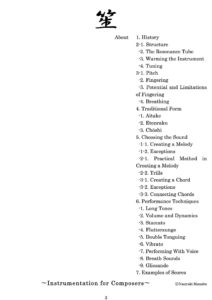笙
作曲のための楽器法
Instrumentation for Sho (English Version)
Instrumentation für Sho (Deutsche Fassung)
真鍋尚之著

振込手数料別(三菱東京UFJ銀行、三井住友銀行、ゆうちょ銀行)
雅楽の簡単な説明から、楽器の構造、古典の演奏方法、旋律や和音の作り方、そして特殊奏法まで。作曲に必要な情報をひととおり盛り込みました。
すでにこの資料を使って多くの作曲家が作品を完成させています。
24ページの本の体裁にまとめました。
はじめに
1300年の歴史を誇る雅楽。
世界最古のオーケストラともいう雅楽の中の楽器“笙”
平安時代以来、雅楽の曲が新たに作曲されることはほとんどなくなった。
雅楽が日本の作曲家のみならず、海外の作曲家からも脚光を浴び出して次々と作品が生まれるようになったのはここ半世紀ほどであろうか?
雅楽の楽器の中でも、また数多くの楽器の中でも特異な存在である笙という楽器。この楽器の存在は多くの作曲家の創造力を駆り立てるのにふさわしい魅力を持っている。
ただ単に神秘的であった楽器から表現力豊かな独奏楽器としての地位を十分に築き上げるだけの魅力を持つまでに進化したといっても良いであろう。
持続する音・和音の楽器から、旋律楽器としての可能性を育み、さらにこの非常に限られた楽器の中から、複雑な幾重にも折り重なる旋律を同時に演奏する多様な表現力を生み出した。
(中略)
優秀な作曲家の研究と探求心により、笙の可能性はさらに飛躍的に進化させ、次々と超絶技巧による作品も生まれている。
これからも多くの作曲家がこの笙のために作品を生み出し、さらならる可能性を進化させていくことを願っている。
作曲のために必要な情報をなるべく多くの譜例を挙げ説明していこうと思う。
2009-2014年4月
真鍋尚之
〜Instrumentation for Composers〜
About
Gagaku is Japanese Court Music which boasts a history of 1300 years. Sho is a wind instrument in this Court Music, which is thought to be the world’s oldest orchestra. After the Heian Period, it became rare for new works of Gagaku to be composed. It is only about the last half-Century where not only Japanese composers, but composers from outside Japan to actively compose new works using the Gagaku instrumentation.
Sho is a peculiar instrument in which it is special in the Gagaku instruments, as well as many other Western instruments. Surely this instrument holds a fascinating appeal, which drives the creativity of the composers. We can say that this instrument has evolved itself from a once purely mystical instrument to an expressive solo instrument.
From producing continuous tones/chords to singing the melody, the sho has much potential yet to be uncovered. Modern composers using the sho in their works dates back to the 1970s where Toru Takemitsu composed a work for a sho and oboe duo “Distance”, and the creation of “秋庭歌” for an Gagaku ensemble. In the 1980s, more works using the sho as a solo instrument, as well as duo and trio, were created. One of the famous piece in that decade is Toshi Ichiyanagi’s “Hoshi no Wa” (Galaxy) – a work which pulled out the potential of the sho. In the 1990s, I feel that modern composers using the sho in their works has drifted away from the technical side of composition, and has been using the sho in a more conceptual, Japanese aesthetical way.
To create a stir in this history of the sho, I have composed a series of works for a solo sho “呼吸”(Kokyu, I~V, 1994 ~ 2006). Also, from the year 2000, I have produced a sho recital (2000, 2001, 2003, 2006, 2008, 2010, 2012) and commissioned many great composers for new works for the sho, where with their research and thirst for knowledge, have created many new works for the sho with multiple performance techniques never seen before.
I wish for more composers in the future to pull out the potential the Sho has. I would like to include many scores as examples and share with you the instrumentation needed to compose for Sho.
March 2009 ~ April 2014
Naoyuki Manabe
Vorwort
„Gagaku“, die japanische traditionelle kaiserlische Musik, hat mehr als 1300 Jahre Geschichte.
Deshalb sagt man, Gagaku sei die älteste Ensemblemusik in der Welt.
Trotz der langen Geschichte wurde nach der Heian-Zeit so gut wie kein neues Stück komponiert.
Dass Gagaku von vielen Komponisten ins Rampenlicht gerückt wurde, und dass ein neues Stück nach dem anderen komponiert wurde, und zwar nicht nur von japanischen Komponisten sondern auch von westlichen Komponisten, ist eine neue Entwicklung, die wahrscheinlich erst ein halbes Jahreshundert alt ist.
Die „Shō“, die japanische Mundorgel, ist ein Instrument, das eine besondere Ausstrahlung hat, nicht nur innerhalb des Gagaku oder anderer japanischer Musik sondern auch unter den Instrumenten der Welt überhaupt. Deshalb inspiriert sie die Schöpferkraft des Komponisten und übt eine starke Anziehungskraft auf viele Komponisten aus.
Wahrscheinlich kann man sagen, dass sie sich aus einem mysteriösen Instrument, das nur orgelpunktisch akkordisch eingesetzt wurde, zu einem ausdrucksvollen Solo-Instrument entwickelt hat, das zugleich vielfache Melodien spielen kann.
Seit den 1970er Jahren haben viele Komponisten Interesse an dieser Musik gewonnen, und es wurden Ensemblestücke für Gagaku-Instrumente von japanischen und nicht-japanischen Komponisten komponiert. In den 1980er Jahren wurden viele Solo-Stücke komponiert.
Aber die Entwicklung der Shō hat in den 1990er Jahren ausgesehen, als ob sie ins Stocken geraten sei.
Deshalb habe ich selbst für Shō komponiert (z.B. Kokyū I-V, 1994-2006) sowie Solokonzerte organisiert und dafür Kompositionen in Auftrag gegeben (2000, 2001, 2003, 2006, 2008, 2010, 2012).
Nach meinen Auftritten hat die Entwicklung der Shō wieder einen starken Aufschwung erfahren, besonders nach meinem Konzert 2008, in dem Stücke von Kawashima und Watanabe uraufführt wurden, in denen u.a. die Möglichkeiten der Doppelzunge erst entwickelt wurden.
Dem Forschergeist all dieser talentierten Komponisten ist zu verdanken, dass derzeit ein neues virtuoses Stück nach dem anderen komponiert wird.
Ich wünsche mir, dass sich noch mehr Komponisten für Shō begeistern und dass mehr Komponisten die Möglichkeiten der Shō weiterentwickeln.
Im Folgenden zeige ich die Potentiale der Shō auf und gebe Hinweise zum Komponieren.
März 2009 – April 2014
Naoyuki Manabe
レビューを投稿
Submit your review | |
笙の楽器法について、三木稔の名著『日本楽器法』で不十分なところを補完するためにも必携の一冊。特に、現代的な奏法の可能性についてはここまで突っ込んだものは他にありません!笙の新たな可能性を、この本から学び取ることが出来ます。
通信販売のお申し込み
送料5,000円以上無料
振込手数料別
複数申込の場合それぞれのページからお申し込み下さい。
合計金額はメールにてお知らせします。





